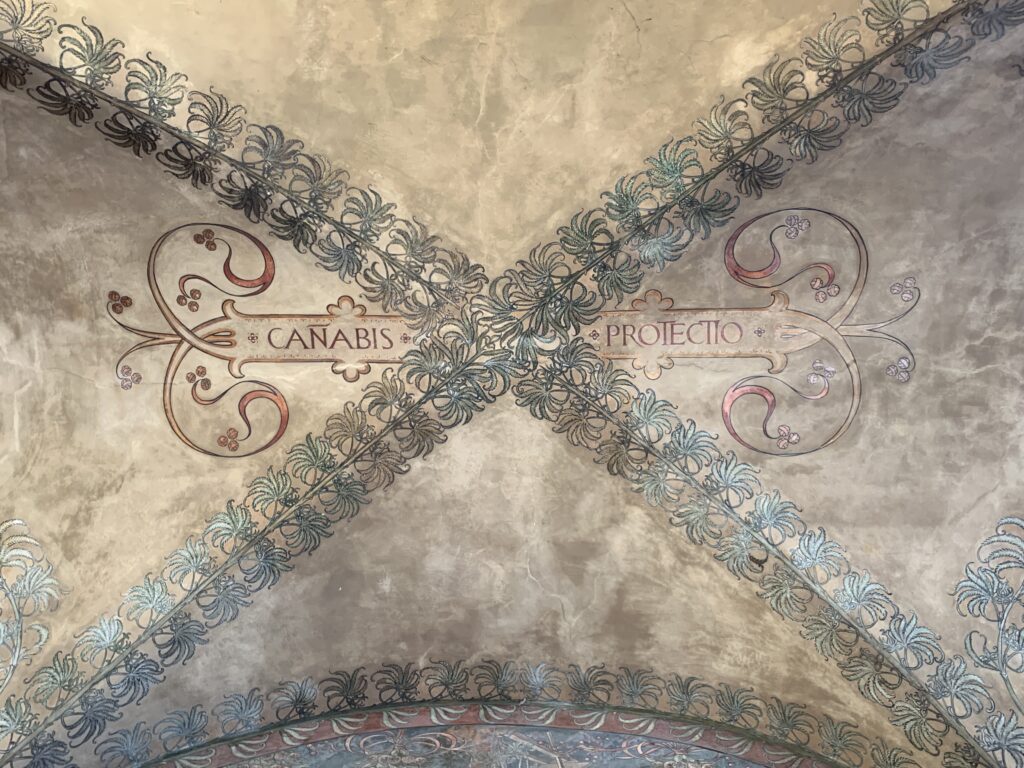Bologna
-
Bologna
December 14, 2019 /History
The first settlements of Bologna date back to the first millennium BC, years in which it represented an important center for Etruscans and Celts. The two names of the city, Bologna and Felsina, originate respectively from the Celtic “Bona” (fortified center) and from the Etruscan “Fetzna”. The Romans dominated Bologna from 189 BC until the fall of the Empire. In 774 the city was conquered by Charlemagne who handed it over to the Pope. In 1115 it became a municipality, and in the XI-XII century its economy exploded thanks to the system of canals and the silk trade. In 1257 it was the first Italian municipality to promulgate the “Liber Paradisus” with which slavery was abolished, and slaves were bought with public money and freed.
In the XIV century, internal struggles undermined the independence of the city which in a few decades was dominated by various noble families (Pepoli, Visconti, Bentivoglio) until it returned under Pope Julius II in 1506. In 1796 it was conquered by Napoleon who kept it until 1815, the year in which with the Congress of Vienna, the city returned to the Pope. Finally, in 1860, Bologna was annexed to the kingdom of Italy

Tour of the city center
Piazza Maggiore
Start the tour from Piazza del Nettuno (1); in 1564 buildings were demolished to make room for this square, where one of the symbols of Bologna was erected. The statue of Neptune was commissioned by Pius IV as a symbol of papal primacy over the world, and the Flemish Jean de Boulogne (known as Giambologna) was hired to sculpt it. The statue represents the god of the sea, Neptune, surrounded by four cherubs that embrace dolphins, to represent the four largest rivers known at the time (Ganges, Nile, Amazon River and Danube). On the four sides of the tank there are four engravings in Latin that say: made to adorn the square, made for the use of the citizens, made with public money and the date of 1564. As the engravings say, in the past it was used by citizens to draw drinking water and to wash clothes. Giambologna wanted to make the genitals of the god bigger without being admonished by the Church: the thumb of the the left hand seen from a particular position appears to be the erect member.
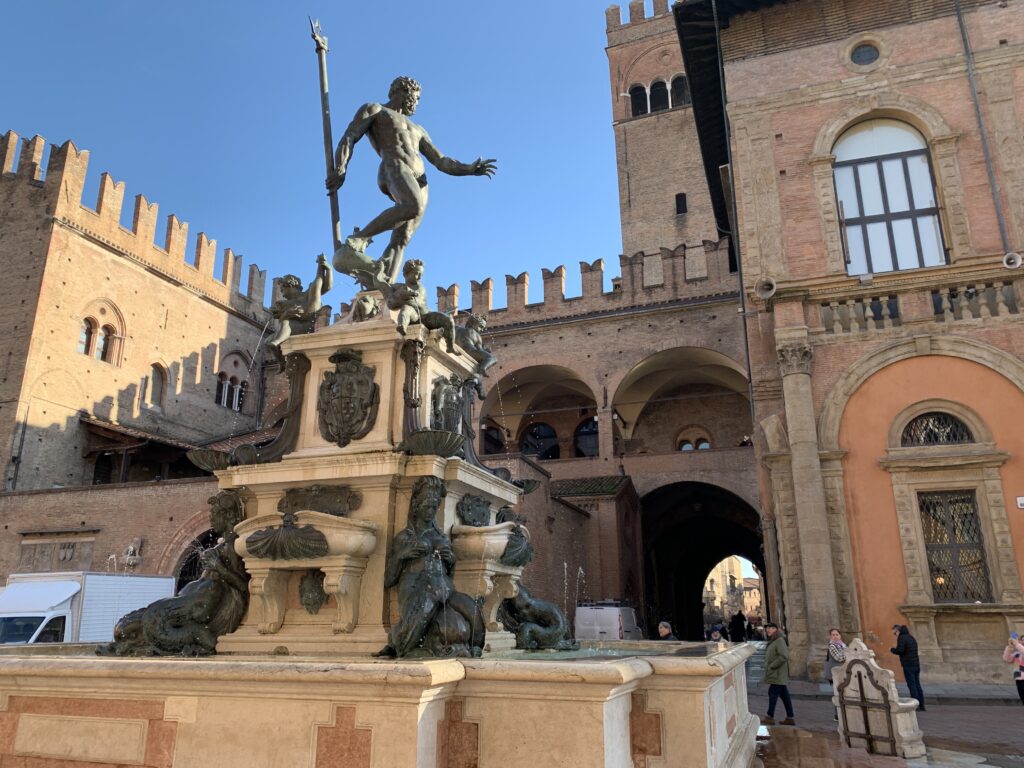
Piazza del Nettuno with Palazzo Re Enzo in the back 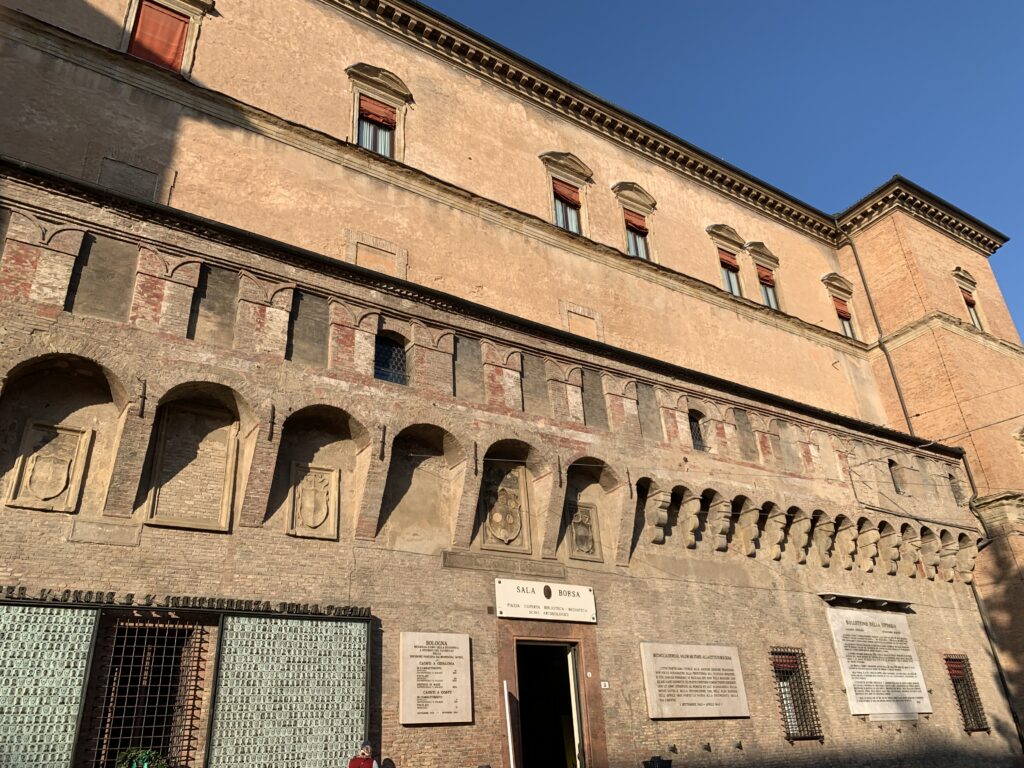
Sala Borsa 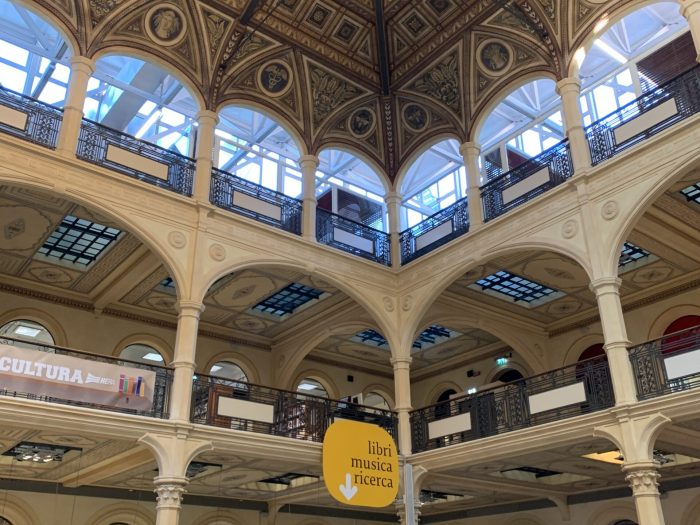
The liberty-style inside Sala Borsa Behind you stands a Milanese-style building commissioned by the Visconti family as the headquarters of the city’s militias. In 1883, with the Kingdom of Italy, the Sala Borsa (2) was built to house the Bologna Stock Exchange (closed in 1903). The art nouveau interior hall had various functions (sports hall) and only since 2001 has it been the seat of the municipal library. It is worth a quick walk inside to see the Roman remains in the trapdoors on the floor.
Back in Piazza del Nettuno, the building opposite Sala Borsa is Palazzo Re Enzo (3), built in 1245 as an extension of the Palazzo del Podesta’. It takes its name from being a prison of Enzo, son of Federico Barbarossa, for 23 years. It was apparently a pleasant imprisonment, as Enzo asked to be buried in the city. The vault by the side of the building was the site of the city hangings: the condemned were first blessed in the little church next to it, now deconsecrated.
Between Palazzo Re Enzo and Palazzo del Podesta’ (4) there is a cross vault with the four patron saints of the city at its corners. If two of you stand at two opposite corners and whisper against the column you will be able to clearly hear the other person’s voice: it was a method used by the priests to confess the lepers
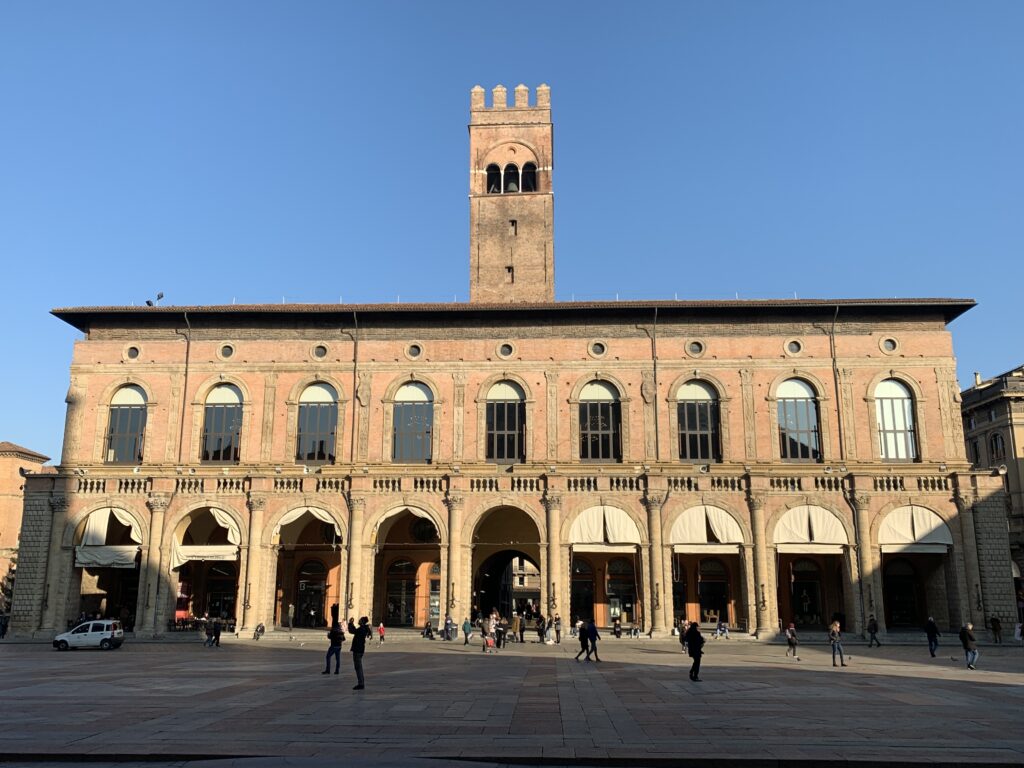
Palazzo del Podesta' 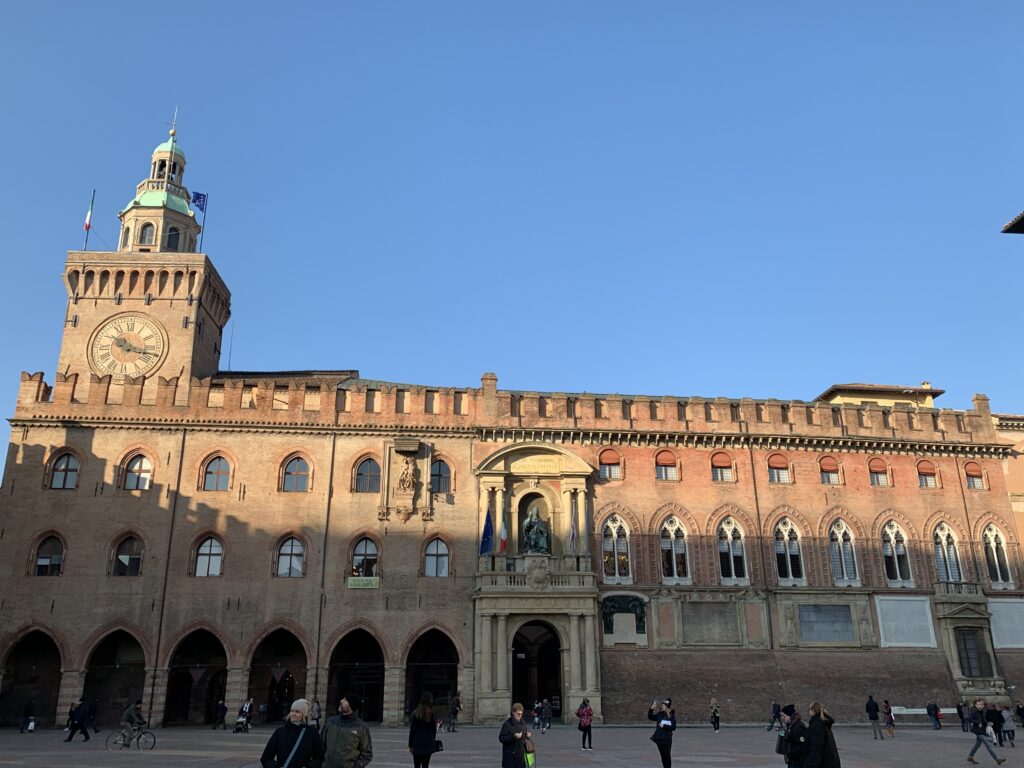
Palazzo d'Accursio From the vault, exit towards Piazza Maggiore (5)and turn around to admire the Palazzo del Podesta’ (4) under which you have just passed. The Arengo Tower is one of the largest suspended towers in Italy: its 5 tons bell was hoisted by Aristotele Fioravanti, architect of the Buda Castle in Budapest, and known for having moved the Templar tower in Bologna by 13 meters to look for gold hidden under it. The bell was ringing to call the Bolognese to gather in case of war, and in the last 100 years it tolled at the end of the Second World War and the fall of fascism.
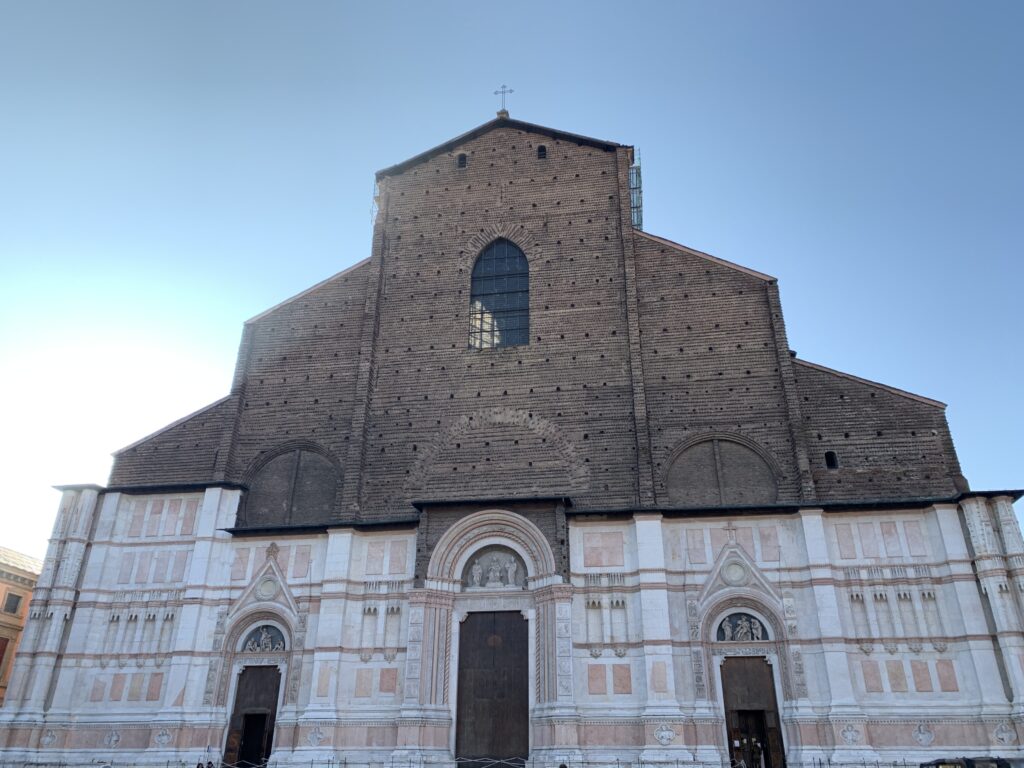
In front of you stands the Church of San Petronio (6), the largest in Bologna, and although unfinished one of the largest in Europe. It’s the largest gothic brick church in the world. It’s dedicated to Petronius, bishop of Bologna in the V century and sent to revive the city from the barbaric invasions. The church was begun in 1390, when Bologna already had a cathedral: the idea of its realization was not born in fact from the Church but for the will of the citizens. The architect Antonio di Vincenzo died 10 years after the workings began. This, together with obstacles from the pontifical prelate, interrupted the constructions for years. In 1514 a new project would have made it bigger than San Pietro in Rome, but it was never put in place. In 1530 Charles V was crowned as emperor of the Holy Roman Empire inside San Petronio.
In 1562 Pope Pius IV decided to give priority to the construction of other surrounding buildings, and the works to complete the church were interrupted for good in 1563. The Church of San Petronio was consecrated only in 1954, and since 2000 has housed the relics of the Saint.
Inside you can see the 4 crosses that for centuries and up to 1798 were outside the gates of the first city walls of Bologna, and which today are oriented as they were then. San Petronio is home to the largest sundial in the world, completed by Cassini in 1657 which measures 67 meters long, and even today misses the astronomical noon by a few seconds only.
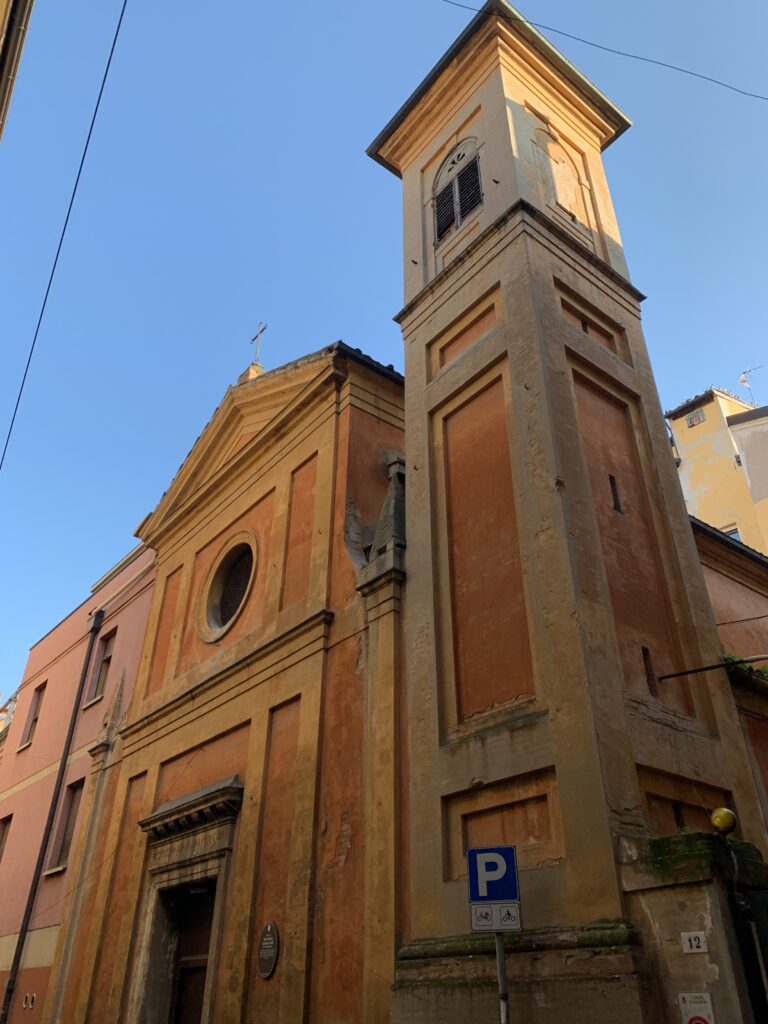
Santa Maria Labarum Coeli 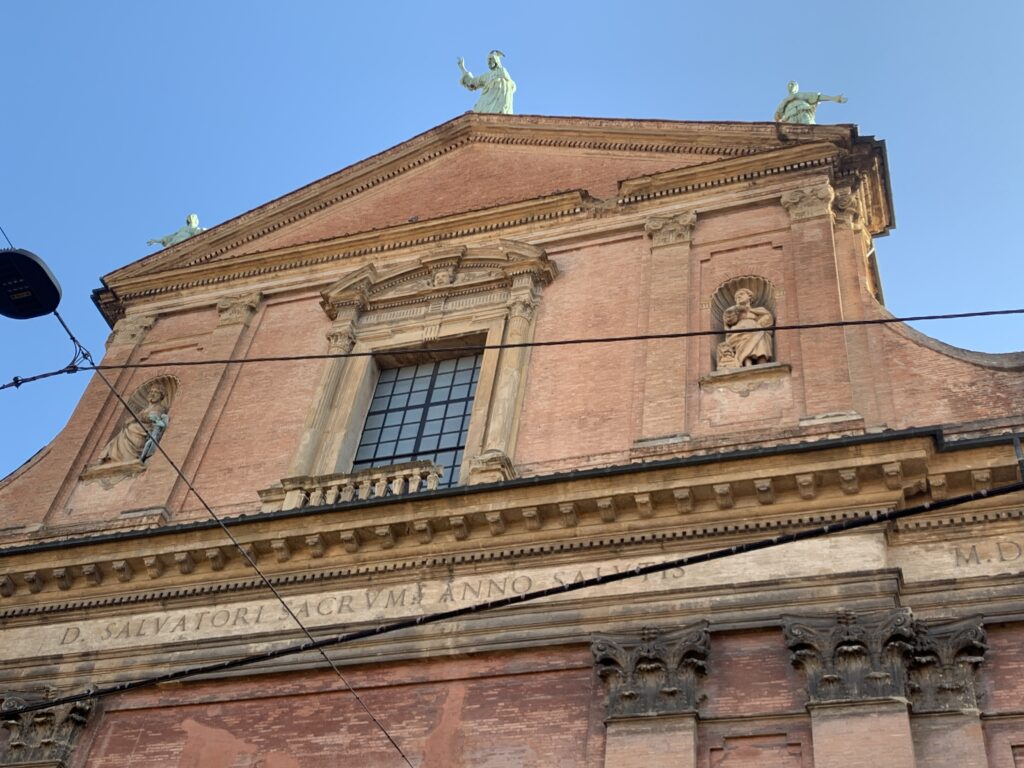
San Salvatore Stroll through Via D’Azeglio (7), turn into Piazza dei Celestini and reach the Church of Santa Maria Labarum Coeli (8), from 1700. Labarum Coeli has no Latin translation: the name comes from the fact that the area was frequented by a prostitute named Baroncella . As the Church could not take this name, it was Latinized. Since 2006 it has hosted the Copts of Bologna.
Take a quick detour to admire the church of San Salvatore (9), very ancient and restored in the 1600s. Raise your gaze to the top of the façade: a large caliber bullet fired by the Austrians in 1849 from the hills of Bologna is clearly visible .
From 1213 the Franciscans are in Bologna and begin the construction of the Basilica of San Francesco (10) which ends in less than 30 years. After the arrival of the French in 1796, the church was deconsecrated and emptied. The church also suffered major damage during the Second World War. The facade is Romanesque but the building is in French Gothic style.
Outside the church of San Francesco there are three tombs of the “Glossatori” which preserve the remains of the first university professors of the Middle Ages; at the time the University was above all jurisprudence, and the “Glossatori” commented on Roman law texts with additions to the margins (glosses).
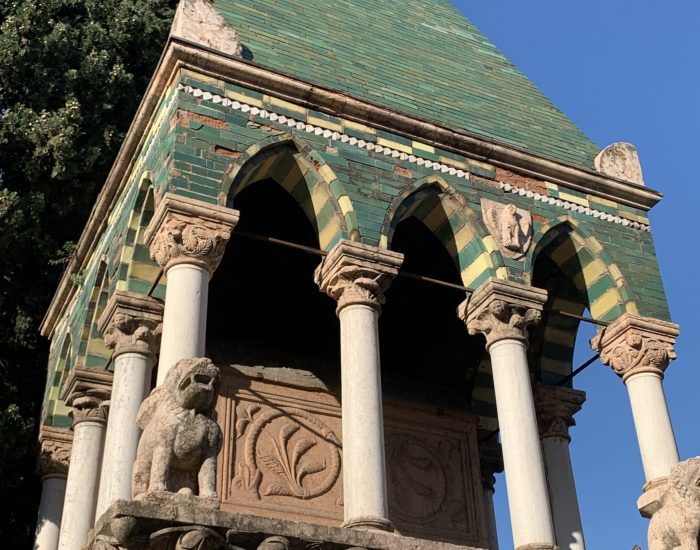
Glossatori Tomb Follow via Porta Nuova to return to Piazza Maggiore. In front of you, on the last side of the square that remains to be explored, opens up the Archiginnasio (11). It was finished in 1563 in order to give a home to the University (lessons were first held in public places) which remained there until 1803. Walking along the Pavaglione portico (which takes its name from “papillon” because here were hanging the silkworms) you will reach the door of the municipal library of the Archiginnasio, founded in 1838.
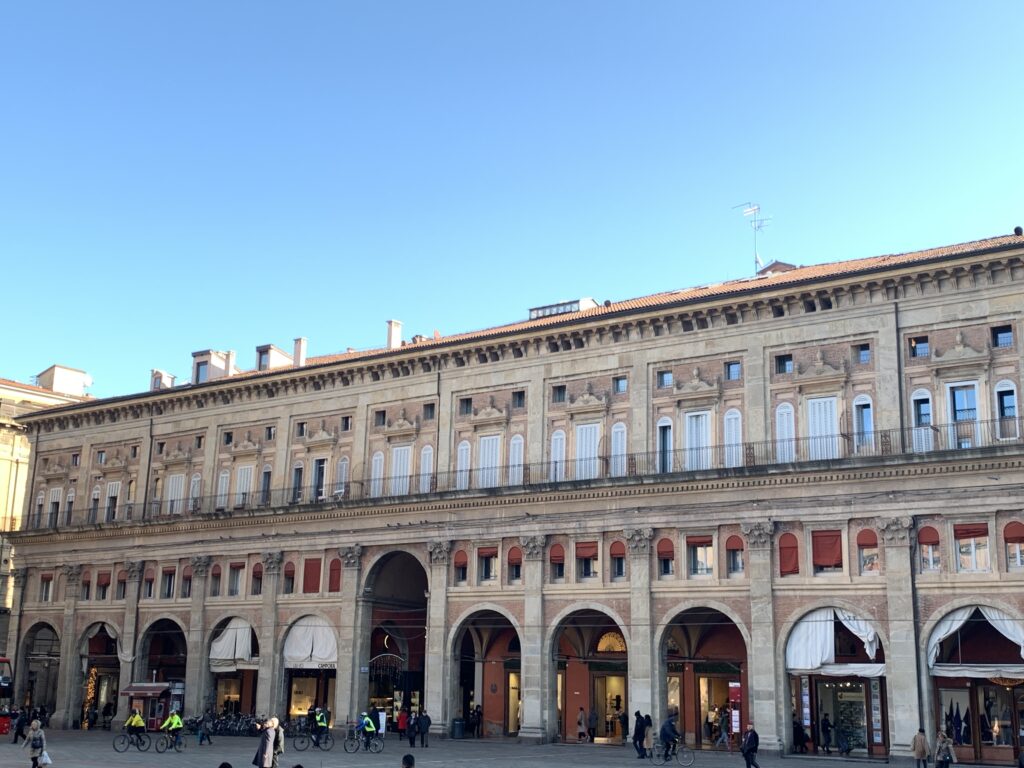
Palazzo dei Banchi and the Portico del Pavaglione 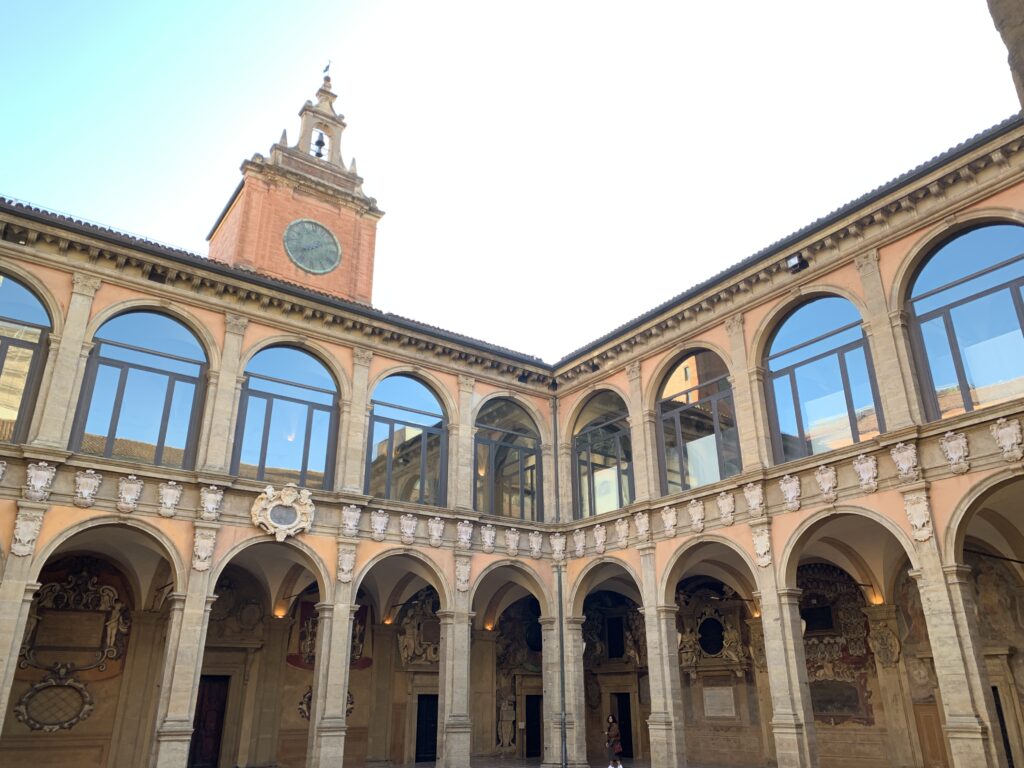
The inside of Archiginnasio Entering the courtyard there are more than 6000 student coats of arms and inscriptions of the professors representing the largest heraldic mural complex in the world. Climb up to the first floor to visit the anatomical theater of 1637. Constructed of fir wood, it has a chair on the right from which the professor read the anatomy books, dominated by a canopy supported by the statues of the skinned, and under it a stand from which the assistant indicated the body parts on the corpse the barber was dissecting on the marble table in the center.
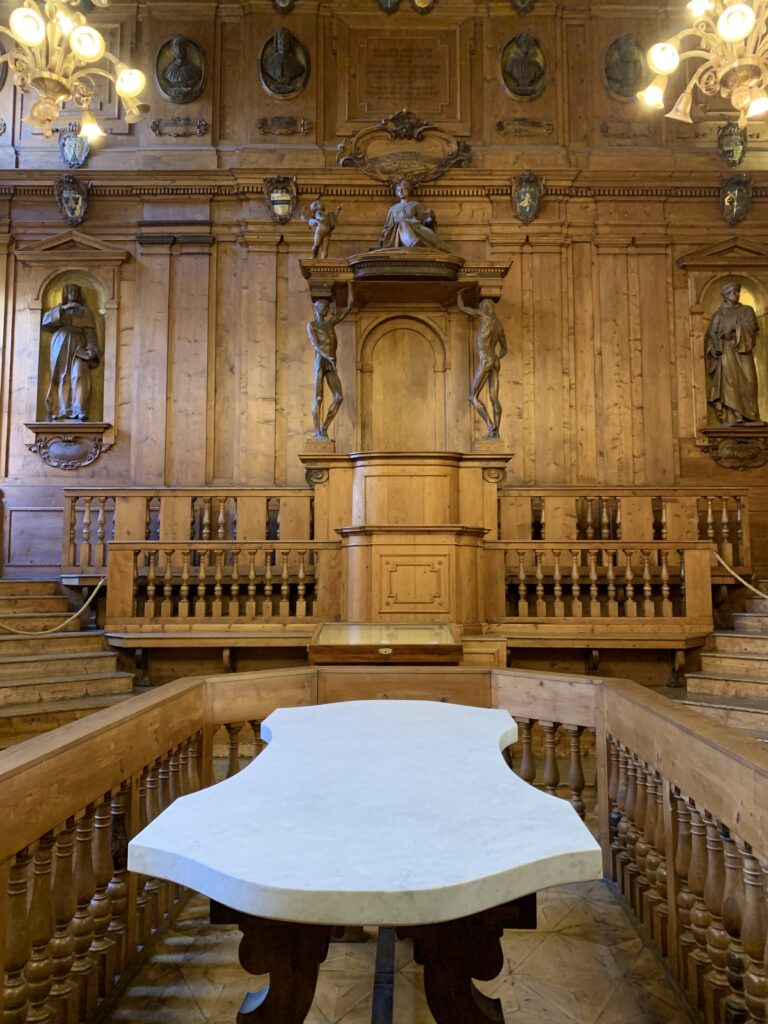
The anatomical theater 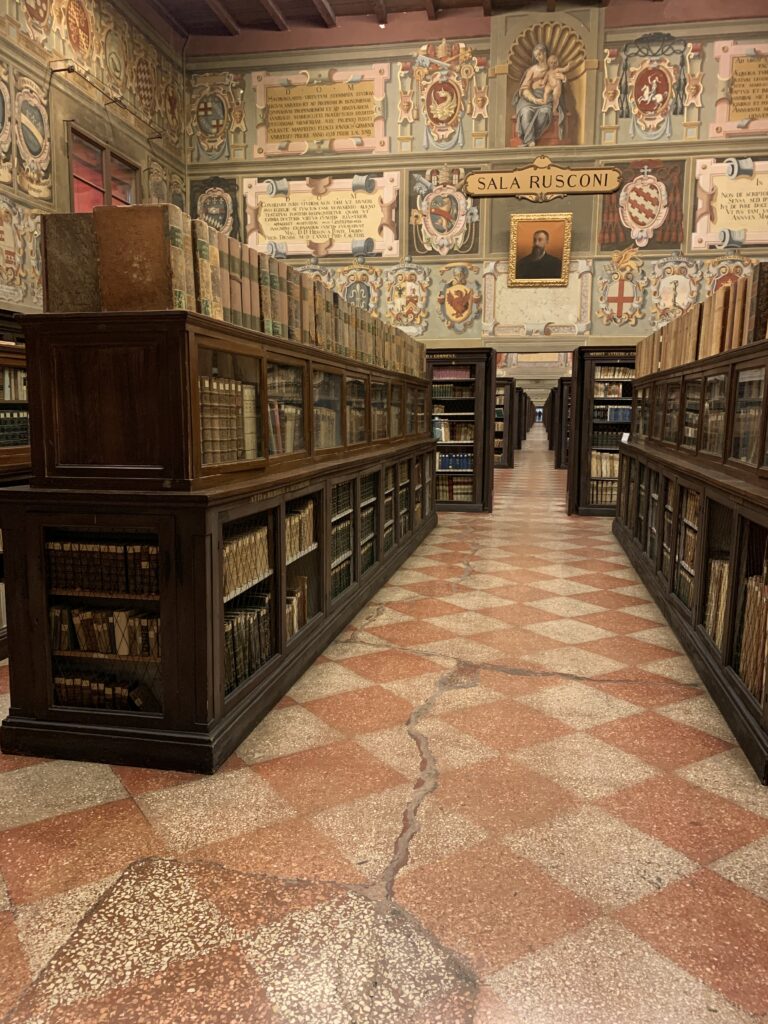
The Archiginnasio library Out of the theater turn left under the portico and continue to the church of San Domenico (12). In 1218 the Dominicans arrived in Bologna and in 1240 completed the construction of the Basilica and the convent, inside which the remains of San Domenico (who died in Bologna in 1211) are preserved. In the square in front of the church there are two more tombs of the glossatori , the first medieval university professors.
The Quadrilatero
Return to the Pavaglione porch and turn right this time into Via Clavature (13). You are entering the true heart of ancient Bologna, where every street takes its name from the trades that were practiced there. Along Via Clavature, on the left side, is the Church of Santa Maria della Vita (14), founded in the 13th century by the flagellar brotherhood. This religious order was dedicated to welfare activity and in 1287 transformed the Church into the first hospital in Bologna. The hospital occupied the entire building between the Pavaglione and the Church, but when the numbers became excessive the first triage was created, and the patients who were too serious were sent to the portico in front of the church, called the Porch of Death (1347).
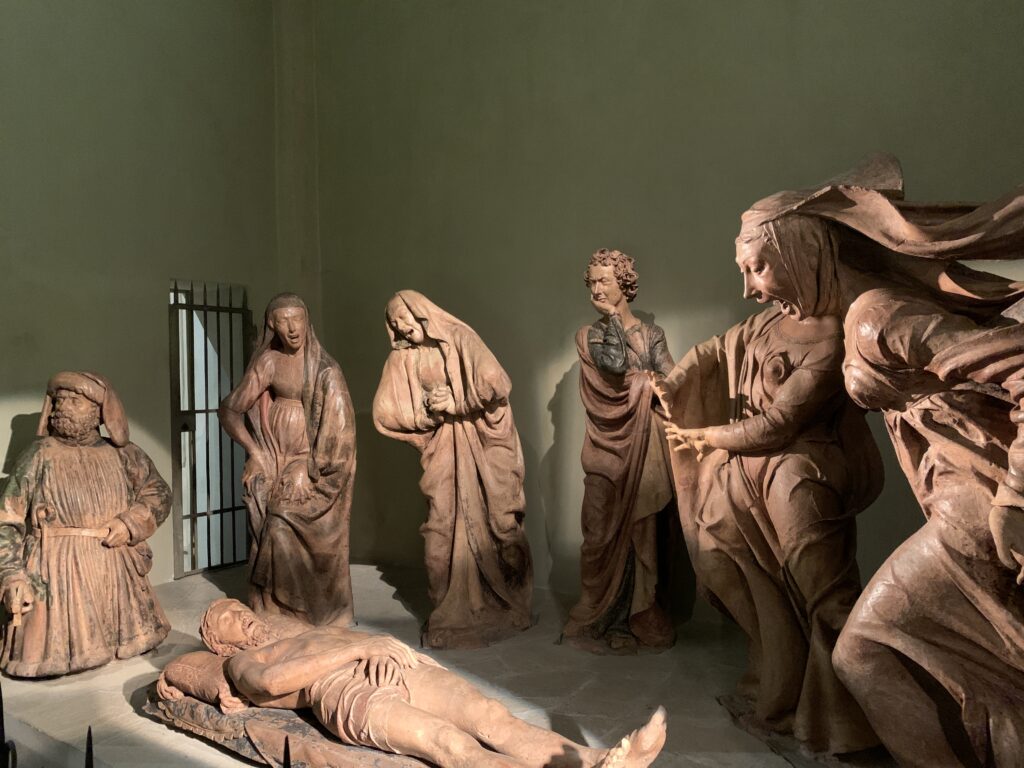
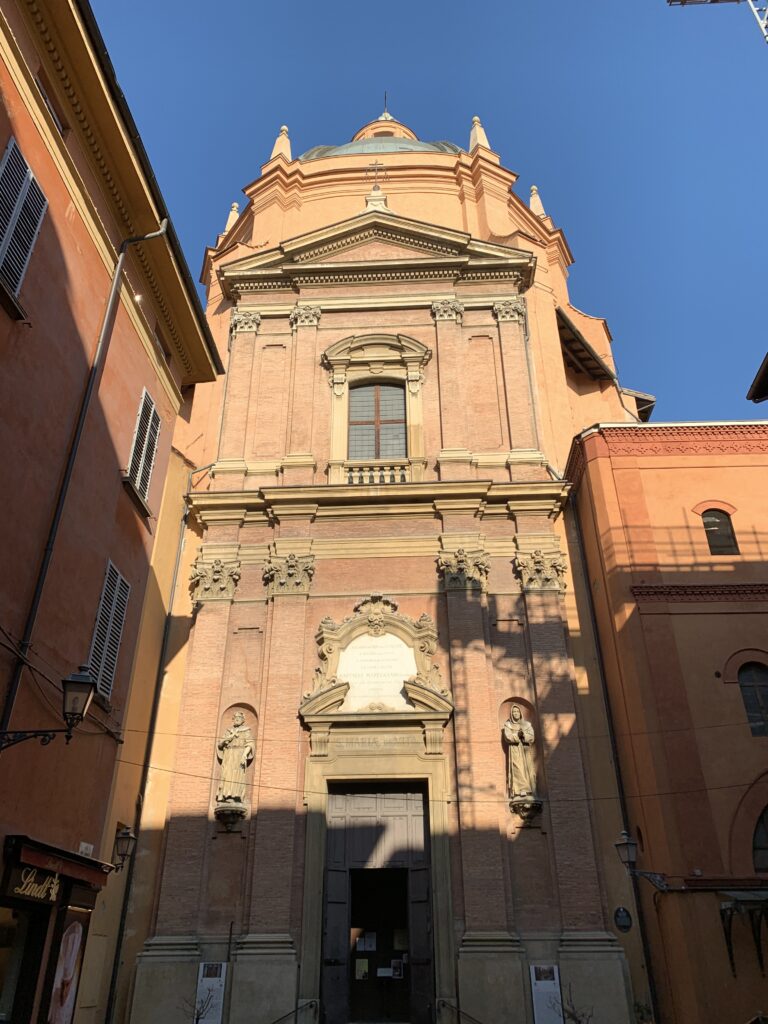
Santa Maria della Vita Enter the Church to admire the Compianto of the Dead Christ of Niccolo dell’Arca (second half of the 400).
Continue your walk in the quadrilatero immersing yourself in the ancient craft and commercial traditions: home to barbers, goldsmiths, fishermen, furriers, blacksmiths, to each of whom one of the streets is named.
Exit the quadrilatero in via degli Orefici and turn right to get to Palazzo della Mercanzia (15). In 1382 the Municipality established the seat of the Foro dei Mercanti in this palace built by the same architect as the Church of San Petronio: once the work was completed, the merchant court was established. Today it sacredly preserve the original recipes of the filling of tortellini, Bolognese ragu’, “certosino”, green lasagna, as well as the size of the real tagliatella (8 mm wide, or the 12270th part of the Torre degli Asinelli, and thick from 6 to 8 tenths of a mm). On the façade of the building that gives on Via Castiglione a plaque from the XV century lists the privileges of the students: to them the municipality paid for books, food and clothing.
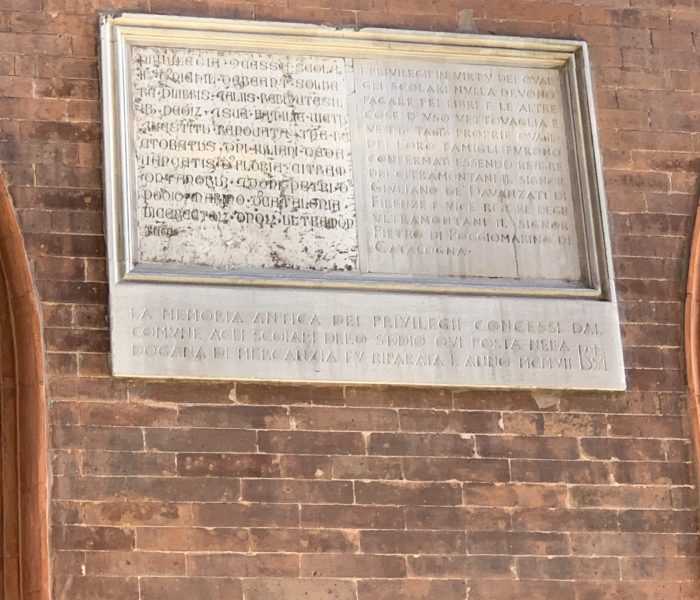
Piazza Santo Stefano
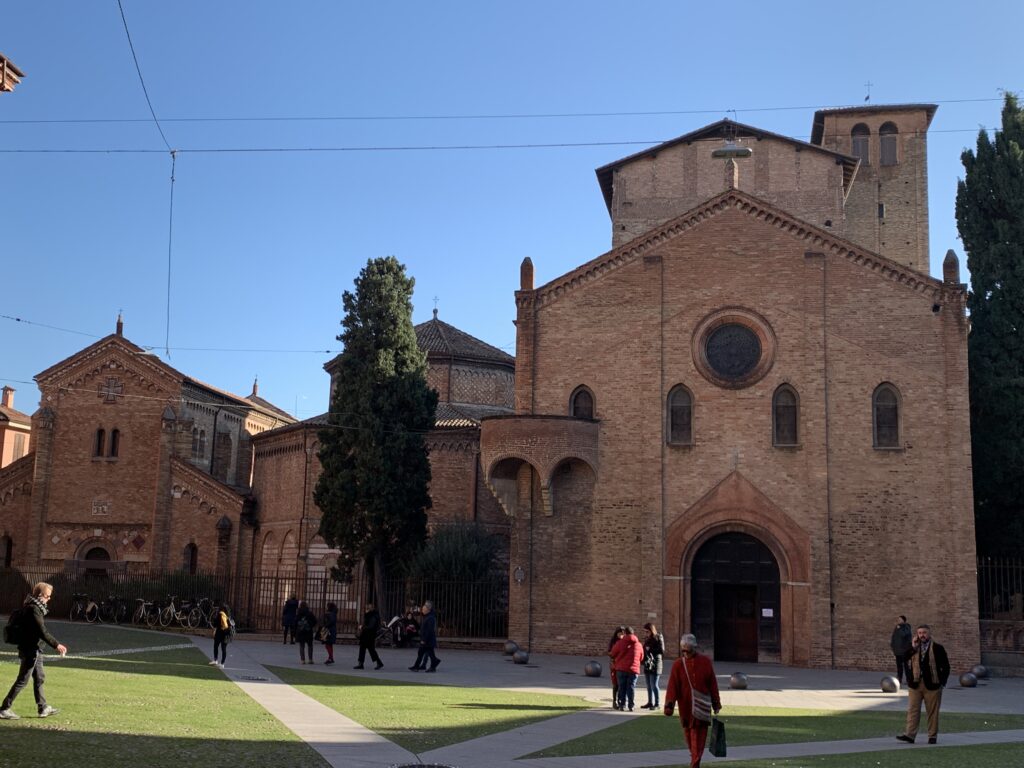
From right to left, Chiesa del Crocefisso, Chiesa del Sepolcro and Chiesa dei SS Vitale e Agricola. In the back, the Chiesa della Trinita' The walk in Piazza Santo Stefano (16) will let you experience with your feet what the ancient Bolognesi were feeling everyday while walking the strees of the city: the pavement is still made of ancient pebbles. Admire in front of you the beautiful Basilica of Santo Stefano (or delle Sette Chiese, the Seven Churches), a complex of very old churches. The church from which you enter is the Chiesa del Crocefisso, of Lombard origin from the eighth century; in the crypt one of the columns is said to be of the same height as Jesus (1.70 m, very high for the time). At the bottom of the crypt two urns hold the remains of the Saints Vitale and Agricola. The church that is immediately on the left is the Church of the Sepulcher, dating back to the 5th century and built by Petronius as a simulacrum of the Holy Sepulcher of Jerusalem. The hexagonal plan of the church and the numerous pillars suggest that it was built on a temple of Isis. Inside, a shrine contained the relics of the Saint Petronio that the faithful could worship the week after Easter by kneeling through a small door (from 2000 the relics are in San Petronio).
In the past, Bolognese prostitutes went to the Church of the Holy Sepulcher on Easter morning to recite a prayer to Mary Magdalene, a prayer that was never revealed. Look among the columns for the one in black marble, symbol of the flagellation of Jesus: touching it would seem to guarantee 200 years of indulgence in the afterlife. The last basilica on the left is the Church of the Saints Vitale and Agricola, the oldest of the complex and dedicated to the first two martyrs of Bologna, victims of Diocletian’s persecution. The basilica already existed in 393, as suggested by the Roman floor. From the last Basilica exit on the Pilate Courtyard: the distance between this point and San Giovanni in Monte (the only natural hill in the vicinity) is the same existing between the Holy Sepulcher and the Calvary in Jerusalem. The small Church of the Trinity at the end of the courtyard had to have a different shape but it was rebuilt in 1800. Since the time of the Crusades there was a piece of the Holy Cross, later removed in 1950. Much more impressive, however, is the medieval cloister on the right, with capitals and tombstones bearing the names of the fallen Bolognesi of the Great Wars.
The churches are therefore 4 and not 7, and none has the name of Santo Stefano …
Just outside the basilica, under the portico on the right, take Corte Isolani (17) to reach Strada Maggiore. Under the wooden portico of Corte Isolani, look up and sharpen your eyes to find three arrows stuck in the wooden ceiling. There are three legends behind them: one of three assassins sent to kill an adulterous noblewoman who, at the sight of her beauty, hurled the arrows at the top; one of an armed conflict; and one that of a goliardic joke made in 1877 by students to the professor who was restoring the porch.
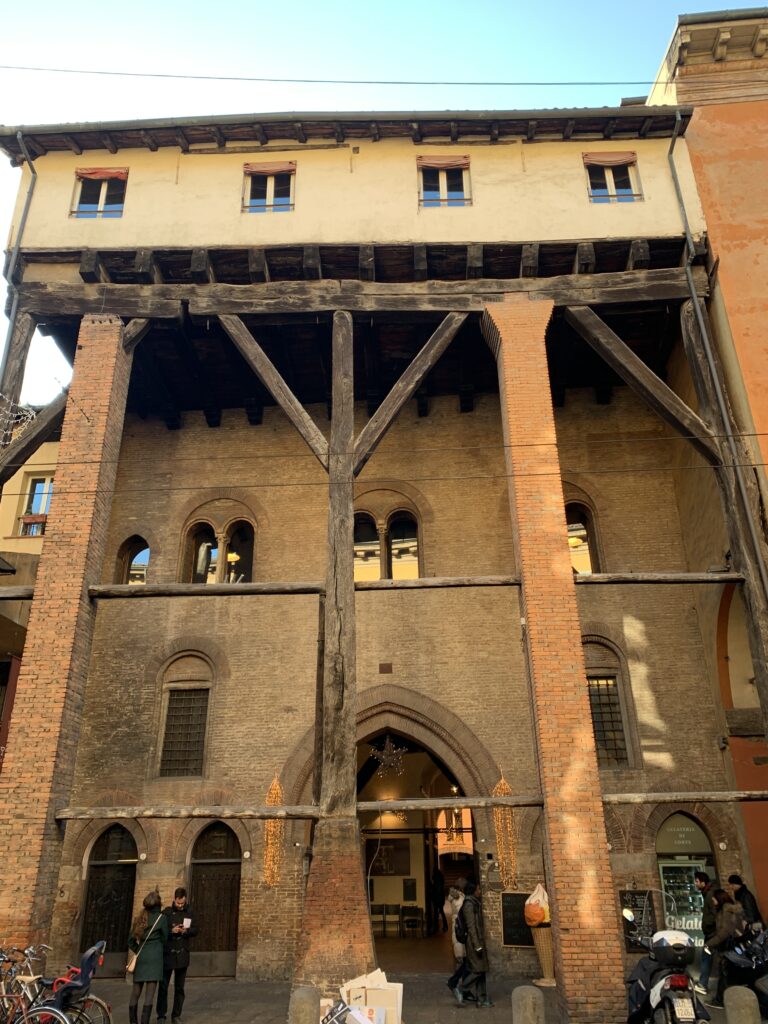
The portico of Corte Isolani, with the three arrowns 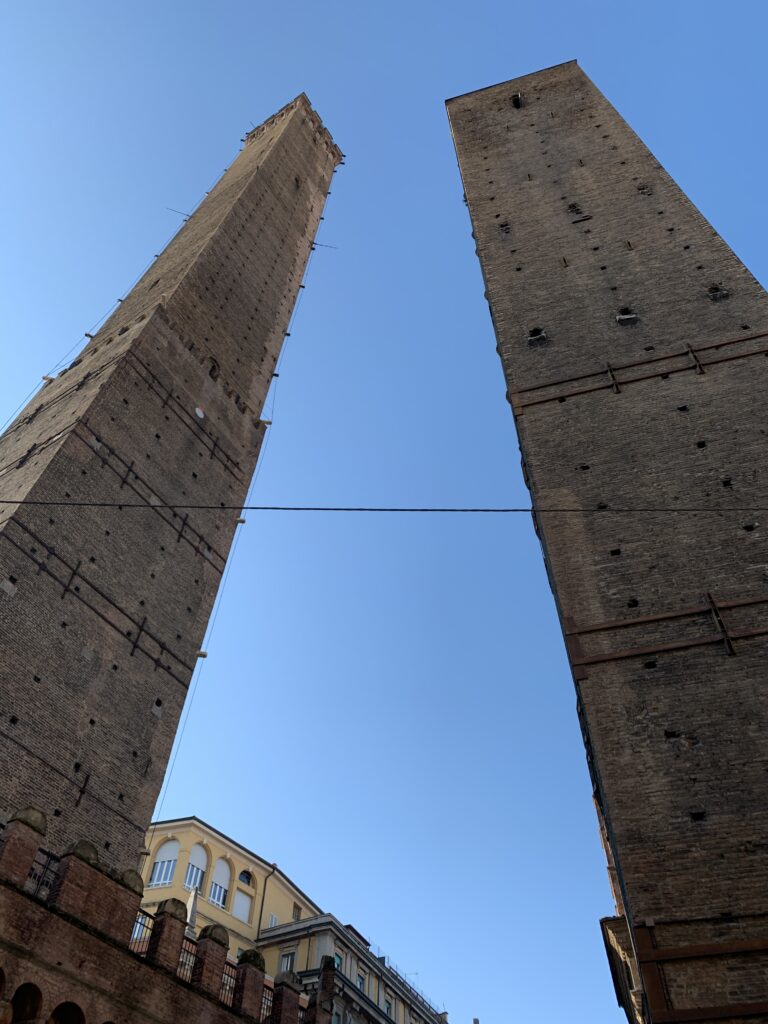
Torre degli Asinelli e Garisenda And now, towards the symbol of Bologna, the two hanging towers (18). They are located at the crossroads of the 5 streets that led to the 5 gates of the city in the year 1000. Despite the names (Torre degli Asinelli and Garisenda), it is not certain that precisely those two families built them.
The Torre degli Asinelli is 97 meters high but from the thickness of the walls of the top floors it is believed that it was originally at least 20 meters higher. Built between 1109 and 1119, its summit was remade in the 1400s. It has a 2.2-meter overhang that makes it the highest hanging tower in Italy. In 1300 it became possession of the Municipality that turned it into a prison. The Visconti made it an observation point, adding a wooden walkway that connected it to the Garisenda. Over the years it has hosted television antennas and during the Second World War it was used to spot bombing and direct relief efforts.
The Garisenda is 48 meters high and has an overhang of 3.2 meters. Initially it was 60 meters high but was cut off in 1351 for the collapse of the foundations. It is mentioned by Dante in the Divine Comedy, and a plaque recalls its verse: if someone leans back against the Tower on a cloudy day and looks up, the moving clouds give the sense that the Tower falls on you.
The University neighbourhood
Walk in via Zamboni (19) and you are in the heart of the university area of Bologna. As you head towards Piazza Verdi, remember that the oldest University in the world went hand in hand with Goliardic associations. And at this point we cannot forget the “taproot” of the goliards. This taproot was originally located in the quadrilateral to prevent access to carriages, but became a meeting place for the Goliardia and a symbol for them. Due to the great rivalries with the other Italian universities, the taproot was repeatedly ripped off and stolen by rivals. When, for urban reasons, it was removed from the original site, the Goliardi raised a protest and occupied the town hall until they obtained the taproot back and carried it in procession and in great pomp in Via Zamboni, where it was walled to the ground (20). After innumerable damage caused by cars, it was restored by the municipality in the 1960s. The engraving on it reads SVQFO (Sacred and venerable order of the taproot).
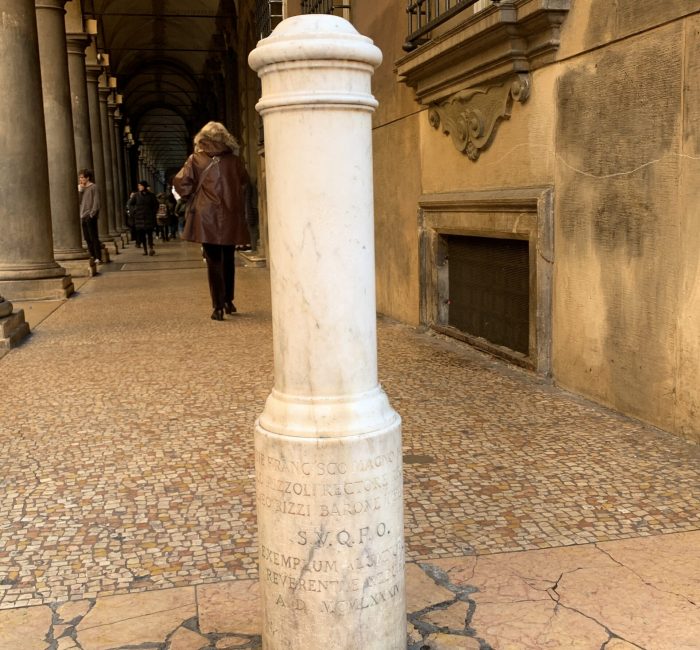
Piazza Verdi is the heart of the university area. The walls you see behind you are a wreck of those of the second circle. Piazza Verdi hosts the Teatro Comunale (21). it is located in the place where the Bentivoglio Palace was standing until 1507, when it was destroyed by the popular fury. Initiated in 1756, it was the first theater built with public funds and rented by the municipality. Opened in 1763 (only second to the San Carlo in Naples, both La Scala and La Fenice are younger), it is a theater closely linked to Wagner: it was the first theater to host the Parsifal outside Germany. In 1931, the director Toscanini was invited to direct at the Comunale but refused to open the concert with the fascist hymn, and was slapped: since then he left Italy for 15 years.
Retrace your steps and at the beginning of Via Zamboni on the left you will find the entrance to the Ghetto (22), founded in 1556 following a papal bull. There are 3 entrances to the Ghetto, this one in particular still has the hinges of the gate. Lose yourself in the lanes of the ghetto, enjoy the absence of cars and head towards via Marsala (23).
The "Portici" of Bologna
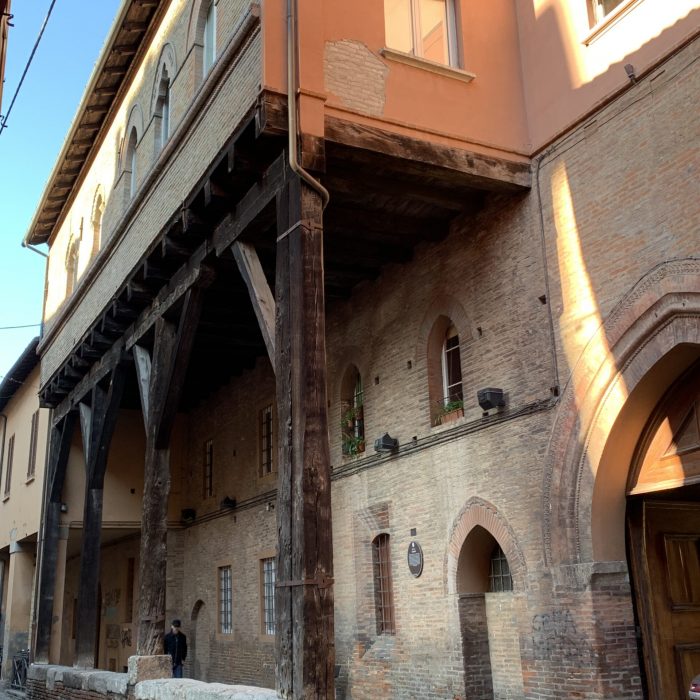
What is missing in the ghetto (the architecture was left to the Jewish community) and that you can find once you arrive in Via Marsala (23), are the “portici”. The famous Bolognese arcades were born in the Middle Ages as spontaneous projection of private buildings on public land. With the boom of the university new houses were needed: the citizens began to extend the beams of the floors of the first floor to the outside, supported first by wooden capitals and then masonry. In 1288 a ban of the municipality established that all the new houses should have a porch and that those already existing should build it, leaving the burden of maintenance to the owner but guaranteeing the use of the land to the municipality. The arcades had to be at least 2.66 meters high (7 Bolognese feet) and wide to allow the passage of a man on horseback. In the poorest areas, very often the measures were not respected. In Via Marsala you can admire the highest portico (of the Officers’ Club) and in front of it the oldest portico. Bologna also boasts the longest portico in the world, the portico of San Luca, with 666 arches and 3796 meters long, built between 1600 and 1700.
The Canals of Bologna
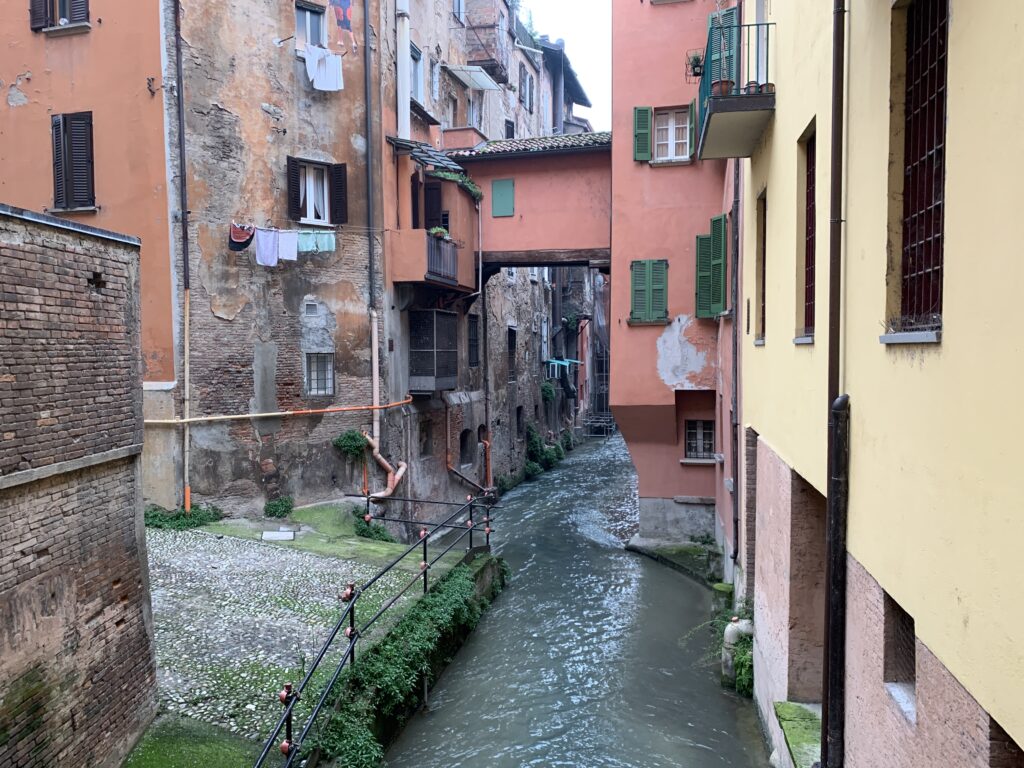
Keep walking towards Via Piella (24). From the river Reno and Savena (west / east) a water network was developed between the XII and XVI. From south to north, Bologna has a drop of about 40 meters. The canals Reno and Savena enter the city together with a stream, the Aposa. The Reno canal is divided into Canale del Cavaticcio (connected to a small hydroelectric power station since 1995) and Canale delle Moline which supplied 15 mills. The Canale delle Moline connects Bologna to Ferrara and flows into the Po, thus linking Bologna to Venice. All this means that until 1950 Bologna had a functioning port. The Bolognese canals served as a means of connection and transport, to regulate the waters of the Apennine rivers during seasonal flow, and to supply energy to the water mills. A series of locks (some attributed to Leonardo) are all that remains of the Bolognese navigable system active from the 12th to the 20th century, without which Bologna could not have developed its economy.
The economic boom of the medieval Bologna was due to silk processing and trading. In 1272 silk processing was exclusive to the city of Lucca, but in that year its secrets were stolen and soon this industry flourished in Bologna. The Bolognesi implemented this industry with the invention of the “bolognese mill”, thanks to which Bologna became one of the most important European silk centers. The Bolognese fleet became notable, so much so as to defeat the Venetian fleet in 1271: the victory granted to the Bolognese favorable commercial duties. Silk was the leading commercial sector in Bologna for a long time and in 1500 40% of the population dealt with silk. In 1600, 119 silk mills were in operation in Bologna.
Admire in Via Piella one of the few uncovered portions of the kilometers of canals that flow under Bologna.
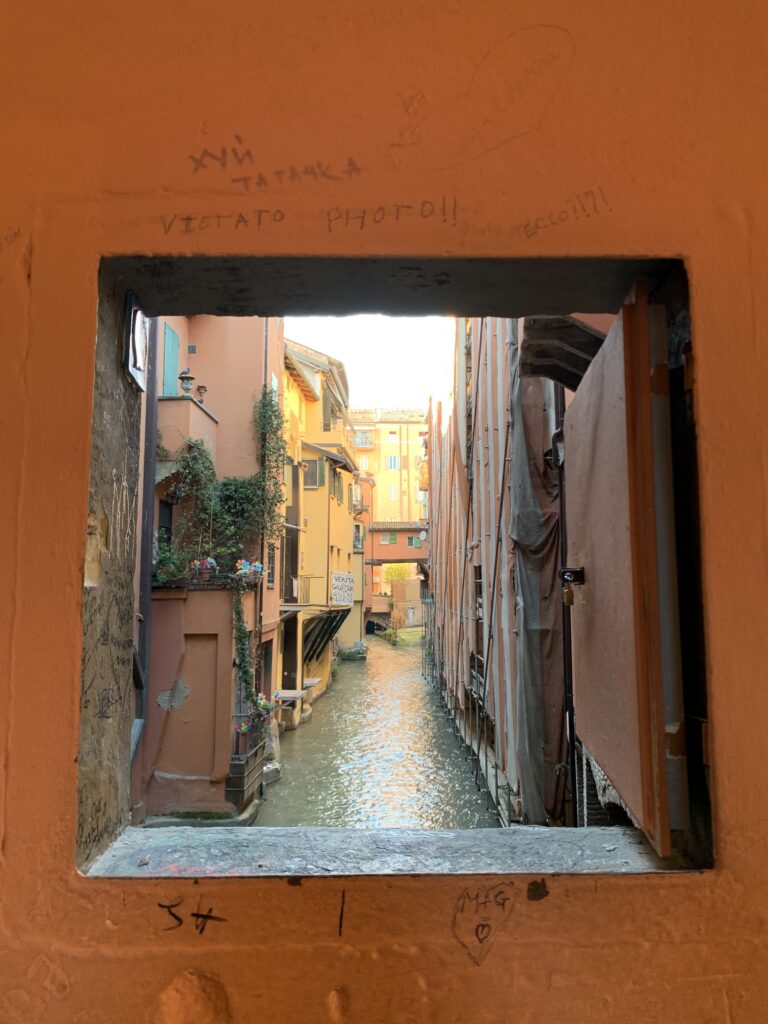
The Towers of Bologna
From Via Piella retrace your steps to see two more of the Bologna towers. The towers of Bologna had a noble and military function, and between 1110 and 1200 there were about a hundred; today there are about 22 left. The towers gave luster to the family that built them, but they could also have offensive or defensive effects. “Tower-houses” were slightly different, lower but with a mainly residential function, less thick walls and more openings. During the 13th century many towers were either cut off, demolished, and some collapsed. The last tower was demolished in 1919. The foundations of the towers go down from 5 to 10 meters under the ground, the base is built with large blocks of selenite and then the tower rises with ever thinner walls. From 3 to 10 years were necessary to build 60 meters of tower.
Reach the Torre Prendiparte (25) (also called Coronata), built in the second half of the 12th century and 59.5 meters high. At 50 meters from the ground there is a “crown” that reduces the thickness of the walls and lightens the tower. In 1700 it was a prison of the Church, various inscriptions of convicts remain including a “held captive for having impregnated two sisters”. A little further on is the Torre Azzoguidi (26), with its 61 meters of height, the second highest in Bologna, and severed as well.
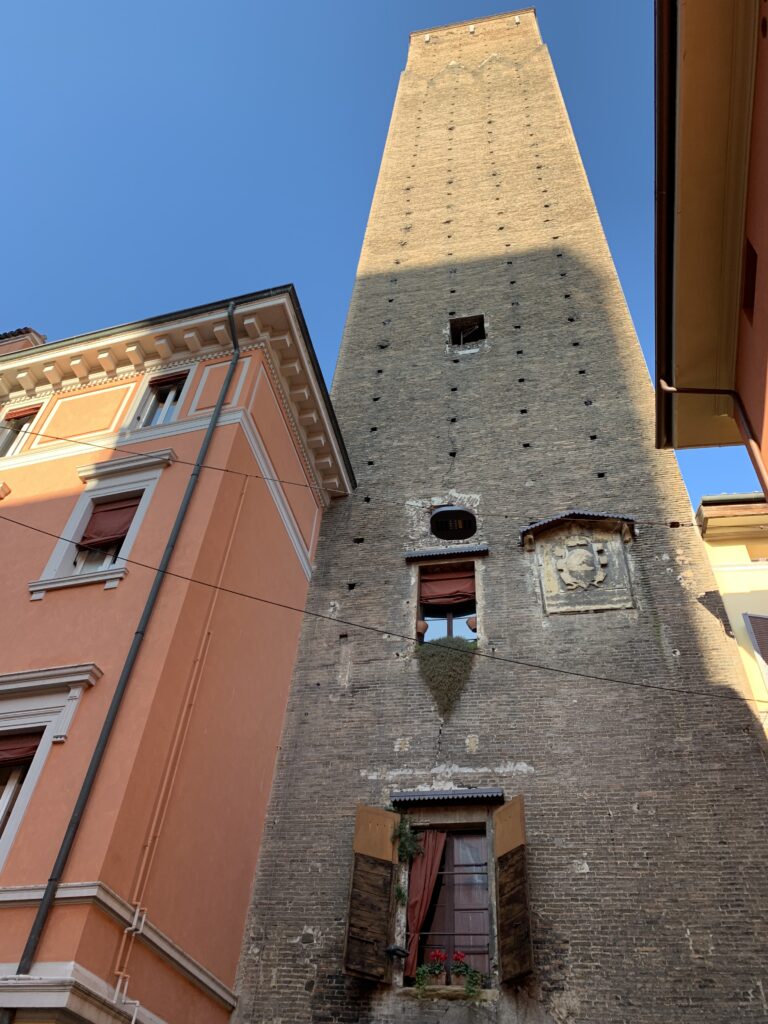
Take a right into Via Atabella and reach San Pietro (27), the true cathedral of Bologna. The first construction dates back to the X-XI century and measured 57 meters in length, but after a fire in 1141 it was completely rebuilt and enlarged in 1184. In light of the numerous basilicas that were being completed all over Bologna, the Church made a (vain) attempt to expand San Pietro and make it more majestic. The current version is from the 1700s, with a baroque facade. The bell tower represents the true jewel of the cathedral: it holds inside a smaller round early Christian bell tower. The largest bell weighs 33 quintals, and together with the other 3 they reach a total of 65 quintals: to ring them, 23 bell ringers are required.
Finish your ride under the portico of Via Indipendenza and look up at the porch ceiling (28). You will notice three writings: “Panis vita”, “Canabis protectio” and “Vinum laetitia” (bread is life, hemp is protection, wine is joy). From 1330 until the second post-war period, the production of hemp with woven use was very widespread between Bologna and Ferrara.
